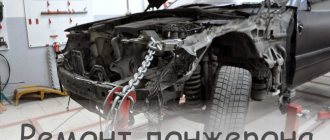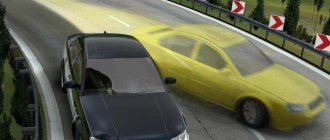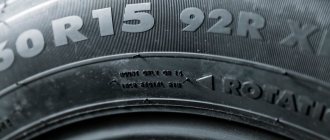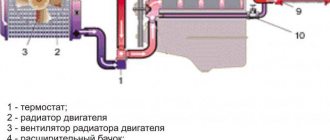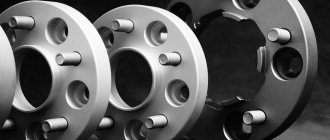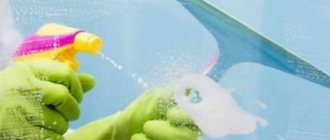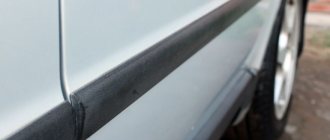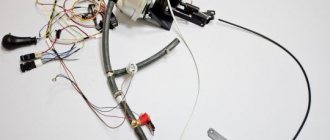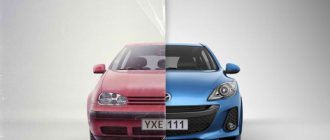Car repair shops can report problems with the car's side members. But what is a spar? It means a longitudinal profile, which can be located in front, behind or run along the entire length. Many vehicle systems, mainly controllability and safety, depend on the integrity of this element. The spar of a car is subject to strong pressure from various forces: the weight of units, passengers, cargo, vibration, external shocks, etc.
Spar - what is this element and what features does it have?
It is best to determine what a side member is in a car based on its function. The main task of the beam is to increase the strength of the bottom. In passenger cars they are 2 slats, and in crossovers and jeeps they almost always have a U-shaped spar.
Rear side members of the car
Visually it can be difficult to assess the role of such an element; to do this, it is worth finding out what will happen if it is destroyed, worn out or absent:
- the bottom sheets will begin to “walk” under the passengers’ feet;
- the entire body will bend somewhat in the center, where the maximum load is concentrated;
- the shape of the door opening will change;
- connectors of body components are deformed and individual fasteners may fall off;
- the position of the motor will be disrupted, it will push through the metal and may cling to the ground;
- if the spar is completely destroyed, the entire body will also be destroyed.
Because the element’s tasks are so important, specialists always inspect the vehicle’s side member during maintenance, repair or restoration of the car after an accident.
The greatest susceptibility to destruction is observed in the front part of the car, and the rear spar accounts for only 10% of all repair work associated with these parts. The fastest way to restore a vehicle is with a frame spar, since structural repairs are carried out with minimal disassembly of the load-bearing part.
An important role is played by the position in which the element is located: horizontal, parallel, at an angle, etc. Each design has its own advantages and disadvantages.
Front and rear spars
To examine the design of the device, you will have to go down under the car from the hood side. Sometimes the places where the front and rear side members of the car are located have additional reinforcements. The rear and midsections may be visible from below, but are sometimes covered by a layer of underbody protection. On many cars, you can see part of the front side member when viewed from above the hood. To find out more clearly where the spars are located, you can study the photo.
How to replace a spar with your own hands
There are quite frequent cases when, as a result of a traffic accident, the rear spar has to be repaired, or even replaced altogether. Or there are situations when, after long-term use of the car, the spar, worn out over time, loses its integrity.
This leads to the body geometry being disrupted, the car is difficult to control, and constant friction against the springs or wheel arches causes premature wear of the tires. And then the driver has to concentrate his attention to the maximum, because with such a malfunction there is a very high probability of the car skidding when turning.
Replacing the spar
What needs to be done in such a situation? Of course, replace the failed spar. Fortunately, modern car markets and auto stores abound with spare parts for any car. As for VAZ cars, there are no problems at all - neither in terms of the spare parts themselves, nor in their price.
Preparing for work
The first step is to choose a room where the necessary work will be carried out. An ideal option would be a spacious garage equipped with an inspection pit.
Before starting work, make sure you have the necessary tools:
- Nice strong hammer.
- Multifunctional grinder.
- Semi-automatic or gas welding.
- Jacks or lifts.
- Chisels and files of different sizes.
Before you begin work on replacing the side member, make sure that there is no fuel left in the gas tank, ensure that it is fireproof, and remove the battery from the car.
Correcting geometry
First of all, before installing the spar, the body of the “ten” must be brought into normal condition, since after an accident or long-term use its geometry is disrupted.
To do this, use a jack or rack lift to raise the rear of the car. After lifting the vehicle in this manner, for the convenience and safety of further work, it should be additionally strengthened with the help of supports. They can be thick logs, iron posts, or hanging chains.
Good advice: one way or another, defects in the car body will need to be corrected. Before editing, take the time to use a marker or chalk to mark the places that will be corrected using a grinder.
Purpose and design of spars
The spar in a car is the basis of the design of almost all passenger cars; it is designed to hold all units together and provide rigid fixation. Most body components are attached to the frame member. The unit bears the greatest number of loads, so jumpers are used to strengthen the structure. The appearance resembles a staircase.
Structurally, the car spar is a rectangular pipe; 2 pieces are used to make a longitudinal set. The standard version has a right and left side member. The structure can be divided into 3 parts: front, middle and back. The left front part and the rear spar are located highest. Almost always they have a parallel direction to each other, but sometimes there are models with slight slopes.
The spar in a car is the basis of the design of almost all passenger cars
There are composite options that look like several metal parts, while other varieties are solid, made by stamping or milling. The spar is predominantly made of aluminum (mainly alloys), titanium and various composite materials. When viewed in cross-section, the part has the appearance of a channel, increasing in places of greatest pressure and thinning in the body area.
The purpose of using a side member is to improve comfort and reduce vibrations in the cabin when driving. For this purpose, the channels are slightly weakened in places of minimal load.
There are 3 main solutions:
- reduction in metal thickness. This approach is called variable cross-section;
- creating cuts and holes to weaken the structure;
- formation of special folds. When loads are created, the spar folds into an “accordion”. The most effective type extinguishes almost all kinetic energy, but it is most susceptible to destruction, and restoration becomes extremely difficult.
The purpose of using a side member is to improve comfort and reduce vibrations in the cabin when driving
The spar is the power unit of the car. For cargo vehicles and reinforced SUVs, the device is included in the frame. For small-sized cars, a frameless design is more often used, in which the spar only strengthens the bottom of the body and luggage compartment. The strength calculation was made in order to withstand heavy loads; even at the time of an accident, the side members do not suffer much, more often they remain practically intact. The structure is assembled to withstand heavy loads for a long time.
Problems and their solutions
Now a little about what the words of automobile masters mean when they talk about “care,” or cracks, deformation, or roll of the spar. This does not mean anything good for the vehicle owner. And only because this part is manufactured using a special technology in a factory, and repairing it even in the most modern auto repair shop can be very problematic. It’s not that there aren’t tools here to level everything, weld it, put it in place.
The fact is that after intervention in the original structure of the spar, there is a high probability of a decrease in its strength characteristics. Therefore, if the spar of the supporting structure is damaged, the car can be prepared for write-off. There are still chances for repairs in cases where it is necessary to replace not the load-bearing part, but the connecting part.
The ideal and most practical solution is to replace it with a new one and not try to repair it. If you decide to trim or weld the spars, do not forget about the need for the integrity of the entire structure. There should not be any inserts here.
It is also advisable to recall a little about the design features of modern cars in terms of side members in order to clearly explain the danger of strengthening and repairing in artisanal conditions. It is important to remember that the front and rear parts are usually deliberately made to be less durable.
Or they are structurally made in such a way that the spar will be deformed in the event of an accident or serious collision. This approach allows you to “take away” almost all the kinetic energy of the impact to fragile parts, allowing the passenger compartment to remain safe even in the event of a serious collision. However, after such a procedure, the car is usually no longer recoverable.
Functions and tasks performed by the structure
The spar has only a few roles, but they are all extremely important:
- connecting. An important task is to connect all the body, chassis and other elements of the system together;
- carrier. The design is designed to withstand loads of any direction and force. Dynamic and static forces act on the side members constantly;
- softening movement. The role of the device is to improve the comfort of passengers while driving by reducing the force of dynamic shocks of the suspension. The design is designed to act as a damper between the suspension and the body. Part of the energy is extinguished in the spar. If it were too strong, passengers would be thrown from side to side. To soften shocks, the device provides places of minimal deformation, due to which most of the energy is absorbed.
Functions performed by the structure
The term itself comes from the French language, where the word means movement along something. This term is applied to many engineering structures of this kind, used in railway, aviation and even ship transport. A supporting structure of this kind is present in most cars, except for those cars where the supporting element is the frame.
In classic passenger cars, the spar stretches along the body and strengthens it in places where passengers sit and heavy elements of the car are attached. In a way, the side members act as a damper between the body and the suspension - part of the energy received from the road, which could be transferred to the body, is absorbed by the supporting structure. If the body were so rigid from the beginning, then passengers and the driver would perceive each blow much more strongly than what happens with such a design.
Therefore, in order to prevent such an effect, the front part of the car is designed in such a way that it can somewhat soften impacts, and not just be completely deformed from them. To accomplish this task, the design provides special design solutions. They are provided in various ways:
- In some places, the spar is slightly reduced in thickness, and the section width changes.
- Technological holes are made in those places that carry minimal static loads.
- Special folds are created, which, in the event of a strong impact during an accident, allow the car's side member to be crushed. Due to this, the body in which people are located suffers less. The supporting structure absorbs kinetic energy and takes on the entire load; the impact transmitted to the cabin due to this is much weaker.
Article on the topic: My attitude towards cars
Types of existing load-bearing structures
The biggest difference is the direction of the load-bearing part and the location of the side members. The type of design differs depending on the role and tasks of the vehicle, as well as the decisions of the manufacturer.
Today there are a number of common types:
- completely horizontal placement with elements parallel to each other. Most often installed on vehicles that require high cross-country ability;
- with slight bends. The curvature is located throughout the bottom, the spars bend around the shape of the bottom, creating a single contour. Improve passenger comfort and effectively reduce vibrations;
- vertical position. The peculiarity of the type comes down to the possibility of creating a flat floor with a significant reduction, greater than that of traditional car models;
- angular views. Increases the passive safety of the vehicle.
The load-bearing part differs according to the transverse type, arranged in all cars. Their role is reduced to creating stiffening ribs, but structurally they are designed differently: inserted perpendicularly between the channels, in the shape of the letter K or X-shaped models. Cross members are almost always made of steel and then bent. In passenger cars, the transverse set is welded to the side members, and in truck models, the riveting method is used. Next, brackets for attaching machine units are attached to the structure.
Spar on Infiniti FX35
Pros and cons of this design
The main advantage of using a spar design comes down to creating sufficient strength for the car with a minimal increase in weight. By keeping the vehicle light, it is easier to control and becomes more maneuverable. The device belongs to the elements providing passive safety.
The design has not only advantages, but also disadvantages:
- all heavy and large units are attached to the spar, this leads to interconnection. When receiving destructive blows during a serious accident, all fixed units are damaged;
- the special design of the side members makes repairs difficult. It is extremely rare to be able to restore a broken channel.
The main problems of the machine related to the side members
The low susceptibility of side members to destruction does not guarantee complete safety. Problems still exist, including:
- A significant problem with the classical design is the vehicle's susceptibility to fatigue. All metal loses most of its strength after 10 years, even without visual damage. In appearance, the spar may be durable, but in terms of technical characteristics it is significantly inferior to the new one;
- severe deformation of the side members when involved in an accident; in the future, the car loses performance even when this component is repaired. It is not uncommon for engine and suspension components to become dislodged after an accident;
- the complexity of the repair is due to the specifics of the design. Channels that have built-in accordion elements or have a variable cross-section are not publicly available. If the device breaks, it will be impossible to return to its original strength except by replacement. If you get into an accident, you must check for damage to the load-bearing part of the car, even if the condition is visually satisfactory.
The method of repair is determined based on the extent and type of damage. The easiest way to replace the side members is in the frame structure; they can be removed with a minimum amount of additional work. If it is the basis of the load-bearing part of the body, it becomes difficult to replace, and sometimes it is impossible to change it. In older cars, the cost of work is such that replacing the side member becomes pointless.
If there is partial deformation, it is possible to pull out the spar, but you will need special equipment that can only be found at large service stations. Using the stand, it is possible to return almost the original characteristics, but it is obvious that the strength still deteriorates somewhat.
After particularly severe accidents, pulling out the spar becomes impossible; the only way out is replacement. If any of the replacement stages are not followed - selection, welding, fastening, etc. - a repeated breakdown may soon occur.
Car side members: what is their function?
As you know, car side members perform one of the most basic functions that ensures safety - load-bearing. They are two cast structures that are interconnected and have the shape of pipes. The body, axles, suspension and other elements that make up any car are attached to them.
View gallery
Most often, the side members of a car are two pipes. One of them is located at the rear of the car, the other at the front. The spar that is attached to the rear is less loaded, since it bears mainly the weight of luggage and passengers. Also, the load is exerted by the axles and the rear of the car body. The spar, which is mounted in front, supports the front part of the body, the engine, the battery, the front axles and other parts that are located under the hood.
View gallery
In view of the above, it should be noted that the side members of the car must be kept clean and tidy. It is important to ensure that no rust, holes or other defects appear on the pipes. You can inspect these parts either independently or at a car service center, the main thing is that the diagnosis is carried out by a knowledgeable person who can identify all the “illnesses” in no time. The car spar can also be processed in the garage or you can use the help of a specialist.
When choosing and purchasing a car, it is very important to pay attention to what loads the spar can withstand. The price may be lower due to non-compliance with any technical requirements, so it is better to spend money by taking a higher-quality model than to then suffer from constant repairs. Under the influence of the weight of all the necessary units that are located under the hood and body of the car, the side members can easily become deformed. As a result, the operation of parts that must work together may be impaired. Often, due to damaged car side members, the steering wheel does not obey the driver, which leads to accidents.
View gallery
As a rule, a standard machine takes into account all the loads that fall on the supporting structures, so deformation occurs extremely rarely. If you are tuning the body, engine or other components of the car, you need to simultaneously strengthen the side members. It is advisable to complete this entire procedure in advance, since in the future new parts may have an unbearable impact on the supporting pipes, as a result of which they will gradually begin to bend. Aligning side members is a long-term and very expensive process, which also requires considerable knowledge and skill.
As you already understand, monitoring the condition of the load-bearing structures of the car is the main task of any car enthusiast. After all, it is much easier to prevent a breakdown than to then shell out huge amounts of money for repairs. It should be remembered that an excessively displaced spar can no longer be repaired or replaced. In such cases, the entire body is replaced, and in some cases the mechanics of the car are replaced. Therefore, do not be afraid to crawl under your car, check the presence and serviceability of all parts and repair or replace them in a timely manner in your own garage or car dealership.
Conclusion
The particular importance of the spar in the design necessitated the need to preserve and restore the high strength of the device. The condition of the load-bearing part must be monitored and necessary repair work carried out, since due to its importance it deserves maximum attention.
What is a spar? Only beginners can ask this question. An experienced motorist knows everything about this detail. It remains one of the main parts of the design, allowing the transport of large loads and reducing the risk of passengers during a car accident. Once you get acquainted with it, you will be able to find out where the elements are located and how manufacturers use them.
How to check the side members
Rotten front spar
It is possible to detect slight curvature of the side members and changes in body geometry only on a stand. However, serious problems with spars can be identified independently. To do this, you need to check for the following symptoms:
You can find out where the side members are located according to the instructions for a specific car.
- Camber and toe. If there are problems with the side members, there will be incorrect camber and toe-in of the car's wheels. Even with adjustment, it will quickly go astray and the tires will wear unevenly. Gaps between body parts. If there are problems with the side members, the gaps between the parts will be uneven; this should be visible by eye. In addition, the doors, trunk and hood will be difficult to close and open . External defects. Problems with side members can also be determined visually. Externally, this manifests itself in a violation of the geometry of the body. You can also check them from the inside, from the inspection hole. There should be no welds, cracks or other defects on the side members. You can find out where the side members are located according to the instructions for a specific car. Typically, the front spar supports the engine. The rear spar runs under the trunk and the tow bar and rear bumper are attached to it.
What types of spars are there?
The car spar is more like the main supporting beam. It is located along the entire length and performs several different functions. Now designers prefer to use several options, guaranteeing safety while traveling.
Original longitudinal beams are always placed on the car frame. For sufficient reinforcement, a right and left profile is mounted, guaranteeing reliability during the trip. Moreover, in some models the dimensions reach the full length, including bumpers. This ensures maximum strength.
The outer spar of the foam wing console.
Wooden plates - spar flanges - can be glued both to the outer surfaces of the console and into specially made recesses in the consoles.
For the spar shelves for the 850x210mm console, I used wooden rulers purchased from a stationery store. The pins were made from birch skewers with a diameter of 3 mm, the pointed end of which helps “get” into the hole in the spar flange on the other side of the console during installation.
For the spar flanges, I made recesses in the upper and lower planes of the console to the length of the intended spar.
On the lower plane of the console, in the recess for the spar flange, I made grooves and laid the wires for the aileron servo drive in them.
I cut out the recesses for the spar flange using a U-shaped foam cutter, set to size = (ruler thickness - 0.5mm).
Next, I glued the upper and lower flanges of the future spar, respectively, to the upper and lower planes of the console.
After the glue had completely dried, I drilled through holes with a diameter of 3mm at an equal distance from each other along the entire length of the spar and glued wooden pins into them. There were six pins in total on each console. There are no pins at the root of the console - there will be a fastening of the console to the fuselage and docking of the consoles.
After the glue had completely dried, I cut off the parts of the pins protruding from the spar flanges flush with the flanges.
(In the photo, the newspaper stuck to the ruler by accident - without thinking properly, I laid the newspaper so as not to stain the table with glue)))))
All elements were glued with Titano-like Elitance Super glue.
Instead of wooden rulers, you can use balsa 2-3mm thick. Unfortunately, we don’t have aircraft modeling stores, and the ordered balsa will be tens of times more expensive than regular rulers in stationery... You can also use any glue that can glue wood and polystyrene foam - Parkflyer probably has such glue.
The final step is testing the spar for strength. For testing, the console is installed with the extreme points of the spar on the supports. The distance between supports is 680mm.
Photo of the mark on the console with an unloaded spar:
The weight of the test load (a jar of water) is 2900g, the load is installed on top of the spar in the center between the supports. Photo of the mark on the console with a loaded spar (in flight the load will be distributed differently, more evenly):
The deflection of the console in the center of the spar under the load was about 3mm
Now the consoles are strengthened and ready for further processing - sanding and painting or covering with film, I haven’t decided what exactly will happen yet, or rather, the film has not arrived yet. The work continues, I want to finish it by May……………
Spars design
The spars in the photo can be seen in a cross-section of the car. Previously, they were the only reinforcement on an airplane, which is why modern technologies are used in a car. As a basis, there are currently two options that need to be discussed.
Professionals easily describe the design. At the same time, they necessarily highlight both types, since they remain irreplaceable. Manufacturers turn to one of the options, taking into account the weight of the car, as well as the load while driving. A description of both types will allow you to obtain maximum information for a detailed comparison.
One-piece
A one-piece spar remains a useful solution in any car. The profile easily supports heavy weight, which is especially important for trucks and crossovers.
This principle eliminates one of the main functions considered by manufacturers. Although an equally durable alternative that can become a 100% replacement has not yet been selected.
Prefabricated
Prefabricated profiles are considered modern. They are divided into 3 parts, which gives high functionality. Moreover, the rear spar is slightly higher than the front, so you can get additional capabilities. When evaluating such a design, manufacturers show the maximum fulfillment of all necessary points. Such options are optimal for station wagons with low ground clearance. They prevent damage to the underbody and reduce the danger for passengers in the cabin.
Where are the spars located?
The elements are located at the level of the bottom of the vehicle. They are hollow inside and have high strength due to the metals used in the alloy and due to their special shape.
Since the side members look like part of the body, it is easier to see them on color schemes for a specific car model. In most cases, they are made in the form of a pipe with a rectangular cross-section. The existing physical characteristics allow the beams to withstand various types of loads:
- dynamic;
- static;
- longitudinal;
- transverse.
The spar in the car is one of the elements of the safety system. The health and even the lives of people inside the car depend on the quality of its execution during emergency situations.
Functions of spars
By comparing front and rear side members, some drivers try to understand the reasons for the complex design. In practice, understanding this issue is not difficult if you correctly evaluate each function taken into account. They will provide a useful answer to the question, allowing you to understand the reasons for the corresponding choice.
- Additional cushioning;
- Reinforcement of the bottom and mudguards;
- Interior protection.
By evaluating the rear or front spar, you can understand how important functions it performs. This is not just a central beam, but a truly necessary element of the bottom. If you look at each point in detail, you will be able to see useful subtleties.
Extra Cushioning
The prefabricated element is designed specifically to provide additional shock absorption. Relaxation of rigidity gives amazing comfort while driving, so when choosing a car model, this factor remains one of the most important. Manufacturers are gradually switching to this option, reducing the load on the body.
Shock absorption usually requires a complex, multi-faceted system. The use of simplified tools provides an easy way to ensure comfortable travel. This forces us to make design changes rather than try to create a new system from springs.
Reinforcement of the bottom and mudguards
Traveling on poor road surfaces leads to unrealistic difficulties. When understanding the spar of any car, what it is, it is necessary to take into account the function of reinforcing the bottom. It is this that suffers the most from mechanical damage encountered on the road.
Mudguards and underbody are regularly put to the test. To provide reliable protection against serious damage, manufacturers preferred to use spars, which provided reliable protection. Let them not touch small pebbles and gravel, but on a hummock or stone they will perfectly save from the appearance of a crack.
Interior protection
During a collision, rigid beams pose a potential hazard to occupants. Previously, there were cases when some of them pierced the body and fell into the passenger compartment, causing serious injuries to people. This has changed since changes were made to improve travel safety.
The installed beams are now manufactured in a special way. During a strike, they do not remain solid, but gather into an accordion. In this case, potential danger to passengers is eliminated, although body protection is reduced. Brands took this step to completely eliminate the danger to the driver and other people.
Technical concept
A dictionary of foreign words sometimes helps to understand conceptual rhetoric. You need to look for longer among French words, where it stands for “movement along.” It is worth considering that this element is present not only in cars, but it can also be found in railway cars, airplanes and even in the construction of bridges.
A car spar (what is it) is the basic strength part of the body, running almost the entire length.
The vast majority of cars, crossovers, and minibuses are equipped with a pair of side members. They are used to support the weight of the heaviest elements of the vehicle. Longitudinal frame profiles serve as the basis for the engine, suspension components and other systems.
Such beams are connected by special transverse bridges. As a result, the structure is referred to by some experts as a staircase frame.
What are the spars made of?
What is the front side member in any car? A kind of protection. Today, designers use several different materials. Which ones should be known?
- Aluminum alloys;
- Titanium alloys;
- Composite materials.
Each of the materials has its own advantages and disadvantages. Most often, the choice of manufacturers is based solely on monetary costs, since from a technical point of view the compositions remain almost the same. This eliminates cost reduction principles and the use of complex multi-part systems.
The spar is not a simple beam under the bottom of the car. Yes, many drivers treat it this way, but such a mistake should be excluded. Manufacturers continue to develop, looking for better design and material. The functions remain indispensable, so you cannot refuse long-term work. Moreover, owners also need to remember this, checking the condition of the profile in a timely manner, because even minor cracks can lead to a car accident even with a slight impact.
Spar
(French longeron, from
longer
- to go along) is the main strength element of the design of many engineering structures (airplanes, cars, cars, bridges, ships, etc.), located along the length of the structure.
Spar - what is it and what is it eaten with?
The spar is the main strength element of the car structure, which is located along its entire length. Two spars, between which there are transverse elements, form the frame. It, in turn, is used as a support for fastening the body, suspension elements and other car parts. Essentially, the spar looks like a metal profile or pipe with a rectangular cross-section.
Spars are of two types:
- located in the front or rear of the car;
- running along the entire length of the car structure.
These are very strong structural elements that can withstand very serious loads created by the weight of the body, power unit, passengers, luggage, etc. In addition, the spars can withstand significant loads during movement, which are formed by the wheels of the car.
The pair of spars that make up the ladder-type frame look like the letter “P” laid on its side. Today, such frames are used on almost all trucks and serious off-road vehicles. Most passenger cars are manufactured using a monocoque body. Spars are present in the design of every machine.
As we mentioned above, the spars are subject to significant loads. If the permissible values are exceeded, these structural elements may become deformed. This has an extremely negative effect on the basic parameters of the car. For example, the position of car elements in relation to the body often changes. This means that the engine, front and rear suspension parts, doors, fenders and other components of the car are positioned incorrectly in relation to the main body structure.
In most cases, spar deformation is the result of a serious accident. If this part is damaged, restoring the original dimensions and parameters of the body can be very difficult. You've probably seen more than once how some cars "chew" rubber on their wheels literally before your eyes. This problem occurs when the car is not properly restored after a serious accident.
Another sign of this problem is that the car constantly “steers” to the left or right. We also note that in the event of serious damage to the car in a traffic accident, it is very important to carry out a thorough diagnosis of the side members, as well as other structural elements.
The stretching of side members after an accident is carried out using special equipment. Before performing the procedure, a serious disassembly of the vehicle is carried out. It is not always possible to obtain the required result. Many craftsmen do not want to take on such work. And replacing it is not so easy. If you are offered to repair side members using welding, you need to understand that the characteristics of this structural element will never be able to return to factory values.
This should not be neglected, since the safety of the vehicle crew depends on it. The spar, which is part of the ladder-type frame, must be replaced. If we talk about serious deformation of this element, changing it is simply pointless. You will have to completely change the car body. Before entrusting the removal of a deformed element to a specialist from a nearby garage, we advise you to weigh everything again and think about whether you are ready to risk safety.
Now you clearly understand what a spar is. In a separate article we will tell you more about how it is pulled out after damage in an accident.
Spar frames of cars [edit | edit code ]
In cars, carriages and locomotives, two spars connected by transverse elements are a complex-shaped metal box that forms a frame (chassis), which serves as a support for the frameless body, as well as for attaching springs, wheels and other parts. In other words, the spar is a metal pipe that has a rectangular cross-section, most often it is a pair of parts - for the rear and front parts. [1]
The classic version of such a frame resembles a staircase in appearance and design, so in everyday life it can sometimes be called a staircase
(ladder frame). Spar frames consist of two longitudinal spars and several cross members [2], also called “traverses,” as well as fasteners and brackets for installing the body and components [2]. The shape and design of the side members and cross members may be different; Thus, there are tubular, K-shaped and X-shaped cross members. Spars usually have a channel cross-section [3], which is usually variable in length - in the most loaded areas, the section height is often increased [2]. Sometimes they have a closed cross-section (box) for at least part of their length. On sports cars, tubular spars and round cross members could be used, which had a better weight-to-stiffness ratio. By location, the spars can be parallel to each other, or located relative to each other at a certain angle. Frame parts are connected by rivets, bolts or welding. Trucks usually have riveted frames, while passenger cars and super-heavy dump trucks have welded frames [2]. Bolted connections are usually used in small-scale production [2]. Modern heavy-duty trucks and trailers also sometimes have bolt-on frames, making them much easier to service and repair, requiring special precautions to prevent the bolts from loosening themselves.
What is a spar in a car?
The front side members are two metal profile pipes.
The spar is supported by the main elements of the car - the engine, wheels, seats, body parts.
The spar consists of two metal profile pipes that are located at the bottom of the car and hold the main elements - the engine, wheels, seats, body parts. In most SUVs, the frame serves as the supporting structure. For passenger cars, a more universal solution is to use side members. They are much lighter, which reduces the weight of the car.
On airplanes [edit | edit code ]
In airplanes, the spars, together with the stringers, form a longitudinal set of the wing, fuselage, tail, rudders and ailerons. The longitudinal elements of the frame usually run along the entire length of the fuselage. Together with the skin, they absorb normal forces when bending the fuselage. Simple stringers and spars are usually made from extruded or bent sections. Spars differ from stringers in being more rigid. For heavy loads, composite spars can be used, consisting of several interconnected profiles. To frame large cutouts in the fuselage, box-section spars are often used - beams, which consist of pressed profiles connected by walls and skin.
A spar wing includes one or more longitudinal load-bearing elements—spars—that perceive a bending moment. [5] In addition to spars, such a wing may contain longitudinal walls. They differ from side members in that the skin panels with a stringer set are attached to the side members. The spars transfer the load to the aircraft fuselage frames using moment units.
Device
The appearance of the car's side member in the video can be clearly seen; it resembles a frame or ladder. And the structure itself is a pipe and can be either prefabricated or solid.
The main material for manufacturing is aluminum or titanium. Therefore, the spar is lightweight and has good absorption of excess energy, which ensures safety.
Typically a pair of spars are installed, which consist of three sections. The nodes are placed parallel to each other, but an inclined arrangement is allowed. The design cuts the entire length of the body, providing maximum support function.

